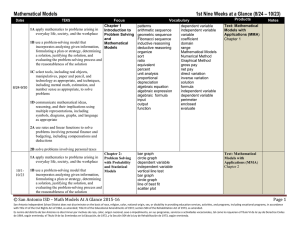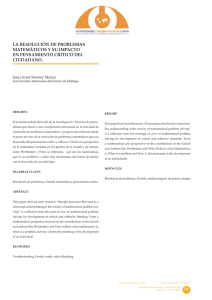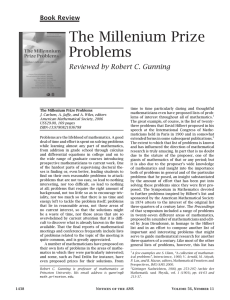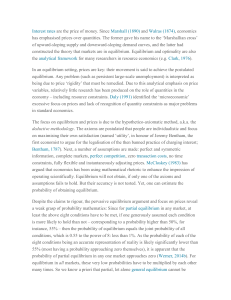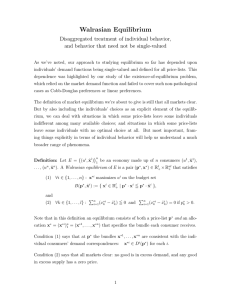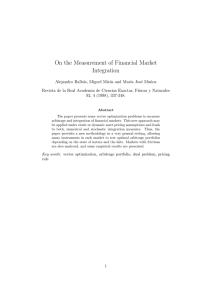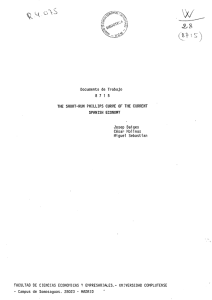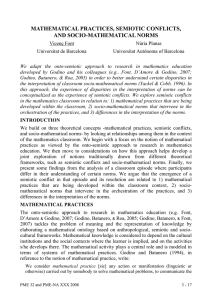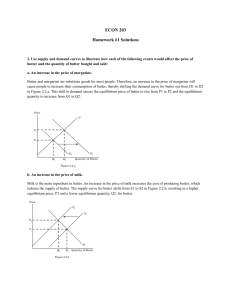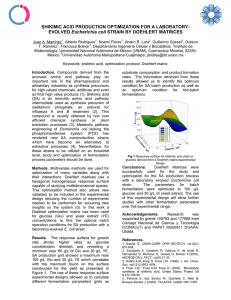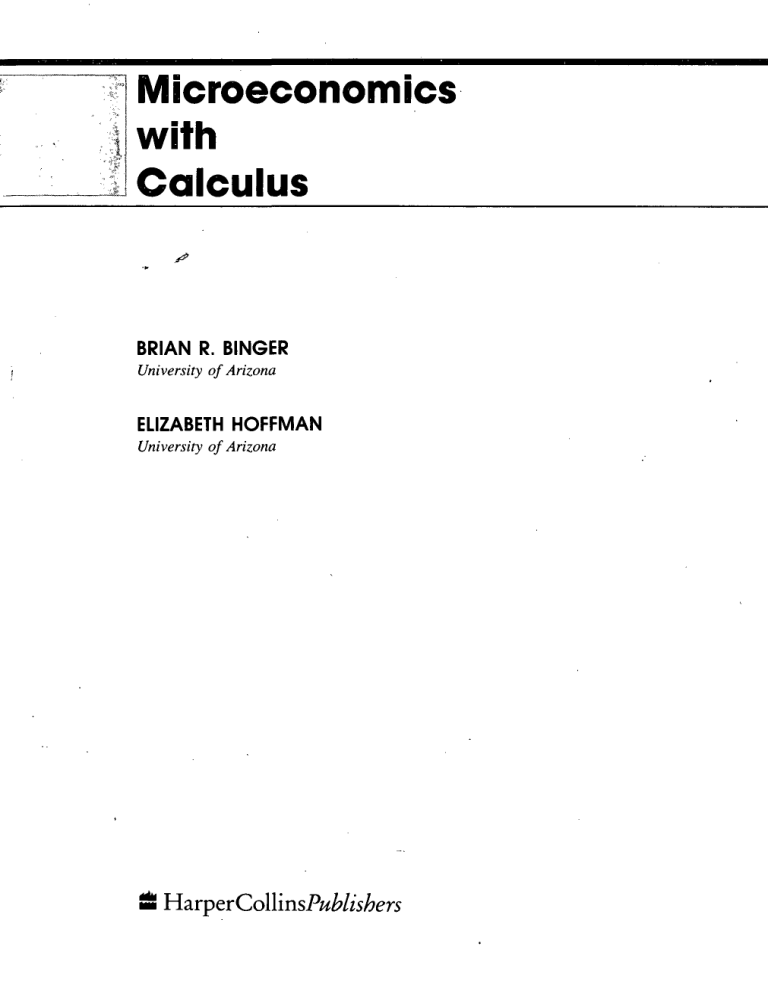
Microeconomics with Calculus BRIAN R. BINGER University of Arizona ELIZABETH HOFFMAN University of Arizona HarperCollinsPublishers CONTENTS Introduction 1 Basic Mathematical Concepts 1 1.1 1.2 1.3 1.4 What You Should Learn from This Chapter 1 Functions 1 Functions of One Independent Variable: Slopes and Derivatives 6 Functions of Two or More Independent Variables: Partial and Total Derivatives 12 1.5 Second Partial Derivatives and Second Total Differentials 18 1.6 More Worked Problems Involving Partial and Total Derivatives 20 1.7 Simple Integration 21 1.8 Review of Key Concepts 24 1.9 Questions for Discussion 25 1.10 Problems 25 1.11 Appendix: Review of Differentiation Rules and Simple Formulas 26 13 2 Unconstrained Maximization and Minimization 2.1 2.2 28 What You Should Learn from This Chapter 28 Functions of One Independent Variable: Unconstrained Maximization and Minimization 29 2.3 2.4 2.5 2.6 2.7 2.8 ^.9 Total, Average, and Marginal Functions of One Variable 34 Functions of Several Independent Variables: Unconstrained Maximization and Minimization 41 One-variable Comparative Statics, Implicit Functions, and the Unconstrained Envelope Theorem 46 More Worked Problems Involving Optimization of Functions of Two Independent Variables 50 Review of Key Concepts 52 Problems 53 Appendix: Relationships Among the Second Total Differential and the Second Partial and Cross Partial Derivatives for Maxima and Minima for Twovariable Functions 53 3 Constrained Optimization 55 3.1 3.2 3.3 What You Should Learn from This Chapter 55 One-variable Constrained Optimization 55 One-variable Constrained Optimization with a Nonnegativity Constraint 56 3.4 Two-variable Problems with Equality Constraints 58 3.5 Techniques for Solving Two-variable Constrained Optimization Problems 63 3.6 The Lagrange Method 68 3.7 Nonnegativity Constraints: Kuhn-Tucker Conditions for Constrained Optimization with Two Choice Variables and One Constraint 77 3.8 More Worked Problems Involving Constrained Optimization 84 3.9 Review of Key Concepts 86 3.10 Problems 87 3.11 Appendix: Second-order Conditions for Two-variable Constrained Optimization 87 3EZIZZIMID 4 Introduction to Economic Theory and the Market Economy 89 4.1 4.2 4.3 4.4 4.5 What You Should Learn from This Chapter The Role of Models in Economics 89 The Economic Problem: Resource Allocation The Market Economy 94 The Model of Perfect Competition 98 89 92 4.6 4.7 4.8 Monopoly, Externalities, and Public Goods Review of Key Concepts 101 Questions for Discussion 102 5 Consumer Preference Theory 99 103 5.1 5.2 „ 5.3^ 5.4 5.5 5.6 5.7 What You Should Learn from This Chapter 103 Cardinal Versus Ordinal Utility: A Historical Introduction 104 The Modern Theory of Consumer Preference 105 Two Utility Functions That Satisfy Axioms 1-6 114 Utility Maximization 115 The Revealed Preference Approach 118 Lump-sum and Per-unit Taxes and Subsidies: An Application of Revealed Preference 121 5.8 Using Revealed Preference to Derive Indifference Curves: A Case Study from Experiments with Rats 127 5.9 Review of Key Concepts 129 5.10 Questions-for Discussion 130 5.11 Problems 131 5.12 Logical and Mathematical Applications 131 3 6 Introduction to Consumer Demand Theory 6.1 6.2 6.3 132 What You Should Learn from This Chapter 132 Consumer Demand Functions: Graphical Development 132 The Ordinary Demand Function: Changes in Demand and Changes in Quantity Demanded 140 6.4 Generalized Demand Functions 142 6.5 Elasticity of Individual Demand Functions 146 6.6 Cobb-Douglas Utility and Demand Functions and Estimation: How Economists Use Specific Demand Functions 149 6.7 Income and Substitution Effects and Downward-sloping Demand: Graphical Illustration 152 6.8 Another Worked Problem: Finding the Generalized Demand Function 158 6.9 Review of Key Concepts 159 6.10 Questions for Discussion 160 6.11 Problems 161 6.12 Logical and Mathematical Applications 161 7 Trading Among Consumers: An Application of Demand Theory 7.1 7.2 7.3 7.4 7.5 7.6 7.7 7.8 7.9 163 What You Should Learn from This Chapter 163 Trade in the Edgeworth Box 164 Solving for a Competitive Equilibrium in a Two-person, Two-good Economy: An Example 171 Efficiency 174 The Distributional Problem 176 Other Resource Allocation Processes and Pareto Optimality 179 Review of Key Concepts 181 Questions for Discussion 182 Problems 182 8 Compensated Demand Functions 8.1 8.2 8.3 8.4 8.5 8.6 8.7 8.8 8.9 8.10 8.11 8.12 8.13 8.14 183 What You Should Learn from This Chapter 183 The Compensated Demand Function 184 The Expenditure Minimization Problem 186 Deriving Compensated Demand Functions and the Expenditure Function: An Example 189 Mathematical Treatment of Income and Substitution Effects 193 The Slutsky Equation 195 Substitution Elasticity and the Size of the Substitution Effect 198 Consumer's Surplus Analysis 202 Practical Applications of Consumer's Surplus Analysis 206 Another Worked Problem Involving Expenditure Minimization 211 Review of Key Concepts 212 Questions for Discussion 214 Problems 214 Logical and Mathematical Applications 215 1E2 9 Market Demand Functions and Demand Elasticity 9.1 9.2 9.3 9.4 9.5 What You Should Learn from This Chapter 216 Market Demand Functions^ 216 Changes in the Parameters of Market Demand: The Case of the Baby Boom 218 Elasticity of Demand 219 Elasticity and Total Revenue 222 216 9.6 The Farm Problem in Historical Perspective: The Effect of Price and Income Inelasticity 225 9.7 How Estimates of Elasticity Are Used for Policy Analysis 226 9.8 Review of Key Concepts 227 9.9 Questions for Discussion 228 9.10 Problems 228 9.11 Logical and Mathematical Applications 229 10 Production Theory 10.1 10.2 10.3 10.4 10.5 10.6 10.7 10.8 10.9 10.10 10.11 11 What You Should Learn from This Chapter 230 The Production Function 230 Recovering Isoquants by Observing Production Choices 234 Output Expansion in the Long Run 237 Output Expansion in the Short Run 238 Diminishing Returns 243 Review of Key Concepts 245 Questions for Discussion 245 Problems 246 Logical and Mathematical Applications 246 Appendix: Proof of the Proposition That Constant Returns Imply Diminishing Marginal Products 247 Cost Functions 11.1 11.2 11.3 11.4 11.5 11.6 11.7 11.8 11.9 11.10 11.11 11.12 11.13 11.14 11.15 230 248 What You Should Learn from This Chapter 248 Economic Costs 249 Cost Minimization 251 Elasticity of Substitution 253 Long-run Cost Functions 255 Long-run Cost Functions and Returns to Scale 258 Using the Cobb-Douglas Production Function: One Way Economists Estimate Long-Run Cost Functions ' 263 Short-run Costs with One Variable Input 266 Short-run Costs with Two or More Variable Inputs 274 Multiproduct Firms 276 The Relationship Between Short-run and Long-run Costs 278 Review of Key Concepts 283 Questions for Discussion 285 Problems 286' Logical and Mathematical Applications 286 313 12 Profit Maximization by a Competitive Firm: Supply of Goods and Demand for Inputs 288 12.1 12.2 12.3 12.4 12.5 ^12.6 12.7 12.8 12.9 12.10 12.11 12.12 12.13 What You Should Learn from This Chapter 288 Competitive Profit Mazimization and Short-run Supply 288 Changes in Short-run Supply 291 Profits and Short-run Shutdown 297 Short-run Demand for One Variable Input 301 Short-run Input Demand with Two or More Variable Inputs 305 Shifts in Short-run Input Demand Functions 306 The Computer Software Company's Short-run Supply Curve and Short-run Labor Demand Curve 308 "Sunk" Costs and Economic Decision Making 310 Review of Key Concepts 311 Questions for Discussion 313 Problems 314 Logical and Mathematical Applications 314 Competitive Market Supply, Market Equilibrium, and Comparative Statics 315 13.1 13.2 13.3 13.4 13.5 13.6 13.7 13.8 13.9 13.10 13.11 13.12 13.13 What You Should Learn from This Chapter 315 Short-run Market Supply Functions 315 Short-run Competitive Equilibrium 317 Experimental Markets: An Illustration of Competitive Equilibrium 320 From Short-run to Long-run Equilibrium 323 Long-run Market Supply Under Competition 329 Short-run and Long-run Adjustments to Changes in Demand and Supply Parameters: Comparative Statics in Competitive Markets 331 The Comparative Statics and Incidence of a Per-unit Tax 334 Deadweight Loss from a Per-unit Tax 339 Review of Key Concepts 341 Questions for Discussion 342 Problems 343 Logical and Mathematical Applications 344 Production Efficiency and General Equilibrium of Competitive Markets 345 14.1 What You Should Learn from This Chapter 345 14.2 Efficiency in Production 346 14.3 Utility Maximization over the Production Possibilities Frontier 355 14.4 Pareto Optimality with More Than One Consumer 360 14.5 General Equilibrium in a Competitive Economy 364 14.6 Comparative Statics in a General Equilibrium Framework 368 14.7 ** Review of Key Concepts 371 14.8 Questions for Discussion 373 14.9 Problems 373 14.10 Logical and Mathematical Applications 374 EZZZIZZ3 15 Monopoly 15.1 15.2 15.3 15.4 15.5 15.6 15.7 15.8 15.9 15.10 375 What You Should Learn from This Chapter 375 Profit-maximizing Output and Input Decisions Under Monopoly Welfare Loss from Monopoly 382 Price Discrimination 386 Peak-load Pricing 392 Natural Monopoly and Regulation 393 Review of Key Concepts 399 Questions for Discussion 401 Problems 401 Logical and Mathematical Applications 402 Oligopoly and Imperfect Competition 16.1 16.2 16.3 16.4 16.5 16.6 16.7 16.8 404 What You Should Learn from This Chapter 404 Interdependent Firms and Nonzero Sum Games 405 The Cournot Duopoly Model and Extensions 411 Conjectural Variation 418 Consistent Conjectural Variations 421 The Stackelberg Model 422 The Model of Monopolistic Competition 424 The Theory of Contestable Markets 428- 376 16.9 16.10 16.11 16.12 16.13 16.14 Repeated Games and Tacit Collusion Monopoly and Oligopoly Experiments Review of Key Concepts 433 Questions for Discussion 435 Problems 436 Logical and Mathematical Applications 429 430 436 Time Allocation, Labor Supply, and Labor Markets 17.1 17.2 17.3 17.4 17.5 17.6 17.7 17.8 17.9 17.10 17.11 17.12 17.13 17.14 17.15 What You Should Learn from This Chapter 437 The Simple Model of Time Allocation and Labor Supply The Backward-bending Labor Supply Curve 443 Overtime Pay: An Application of the Labor Supply Model The Household Theory of the Allocation of Time 446 Competitive Labor Market Equilibria 450 Wage Differentials in a Competitive Market 451 Imperfect Labor Markets: Monopsony 452 Economic Rent and the Welfare Implications of Monopsony Unions 457 Unique Factor Endowments 459 Review of Key Concepts 459 Questions for Discussion 461 Problems 462 Logical and Mathematical Applications 462 437 438 445 455 Intertemporal Decisions and Competitive Capital Markets 463 18.1 18.2 18.3 18.4 18.5 18.6 18.7 18.8 18.9 18.10 18.11 18.12 18.13 What You Should Learn from This Chapter 463 The Two-period Intertemporal Decision Model 464 The Supply Function for Savings 470 Discounted Present Value 473 Determining the Equilibrium Rate of Interest 476 Human Capital and the Demand for Educational Services Exploitation of Nonrenewable Natural Resources 480 Renewable Natural Resources: Trees 482 Optimal Management of a-Fishery 485 Review of Key Concepts 488 Questions for Discussion 490 Problems 491 Logical and Mathematical Applications 491 478 19 Uncertainty: The Basics 19.1 19.2 19.3 19.4 19.5 19.6 19.7 19.8 ^ 19.9 19.10 492 What You Should Learn from This Chapter 492 Introduction to Probability Theory and Risk Preference 493 Expected Utility and the von Neumann-Morgenstern Utility Function Insurance Markets 502 Futures Contracts and Other Long-term Contracts as Insurance 507 Contingent Claims and the State-preference Model 508 Review of Key Concepts 515 Questions for Discussion 517 Problems 518 Logical and Mathematical Applications 518 Applications of Uncertainty Models 20.1 20.2 20.3 20.4 20.5 20.6 20.7 20.8 20.9 497 519 What You Should Learn from This Chapter 519 Moral Hazard in Insurance Markets 520 Adverse Selection 525 The Principal-Agent Problem 529 Risk Sharing and the Principal-Agent Problem in Labor Contracts The Market for Lemons 534 Reputations, Signalling, and Warranties 536 Review of Key Concepts 539 Questions for Discussion 541 532 21 Externalities, Public Goods, and Public Decision Making 542 21.1 21.2 What You Should Learn from This Chapter 542 Optimal Levels of Externalities When Only Firms Are Affected by the Externalities 543 21.3 Optimal Allocation of an Externality That Affects Consumer Utility 548 21.4 Optimal Provision of Pure Public Goods 550 21.5 Externalities and Public Goods in Competitive Markets 556 21.6 Pigouvian Taxes and Lindahl Prices 557 21.7 Problems with the Implementation of Optimal Taxes 559 21.8 Evidence on Free Riding 562 21.9 Coasian Bargaining 564 21.10 Evidence on the Usefulness of the Coase Theorem 569 21.11 Incentive-compatible Allocation Mechanisms 573 21.12 21.13 21.14 21.15 21.16 21.17 Experiments on Incentive-compatible Allocation Mechanisms The Arrow Problem in Public Decision Making 580 Review of Key Concepts 582 Questions for Discussion 585 Problems 586 Logical and Mathematical Applications 586 Answers to Selected Odd-numbered Problems Author Index 591 Subject Index 593 587 577
